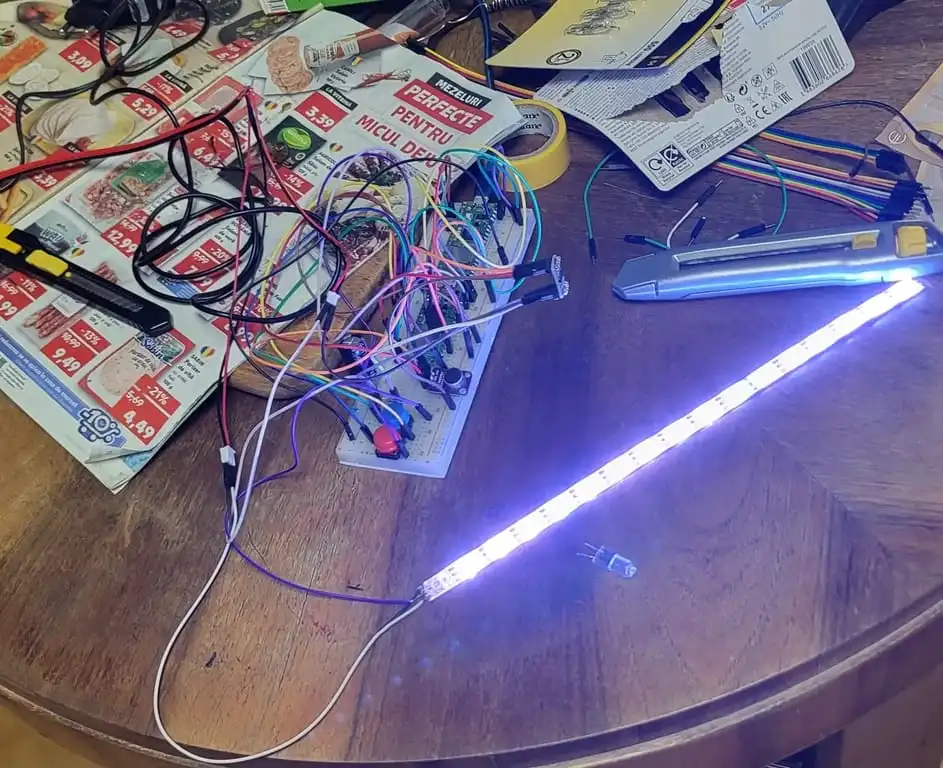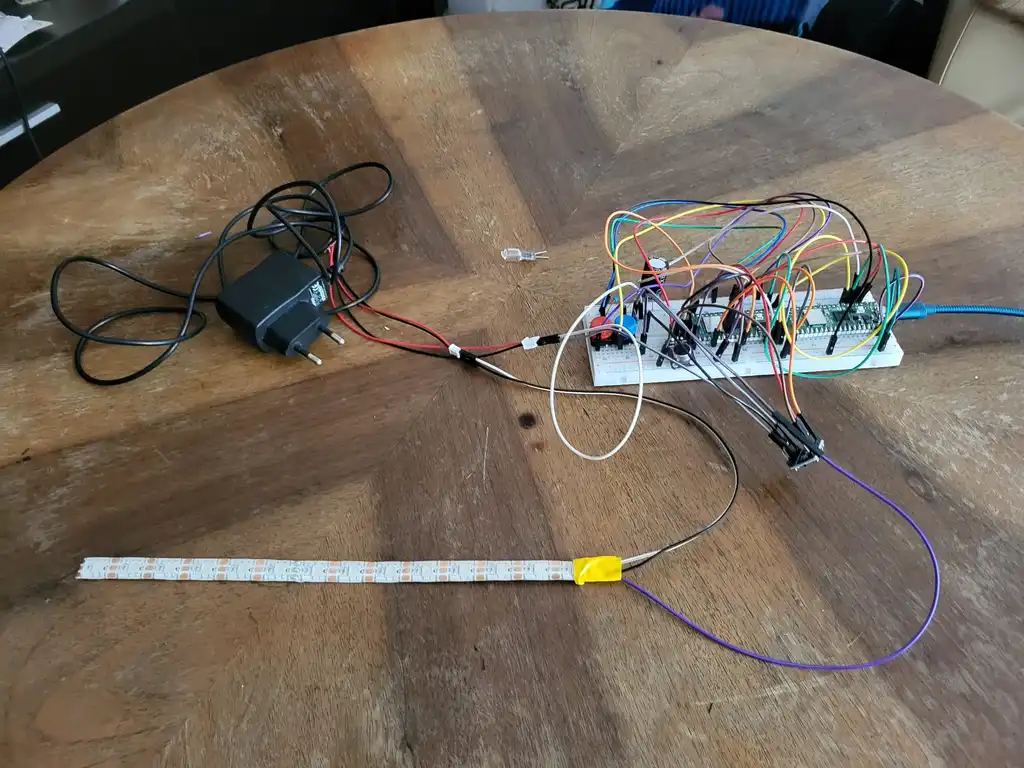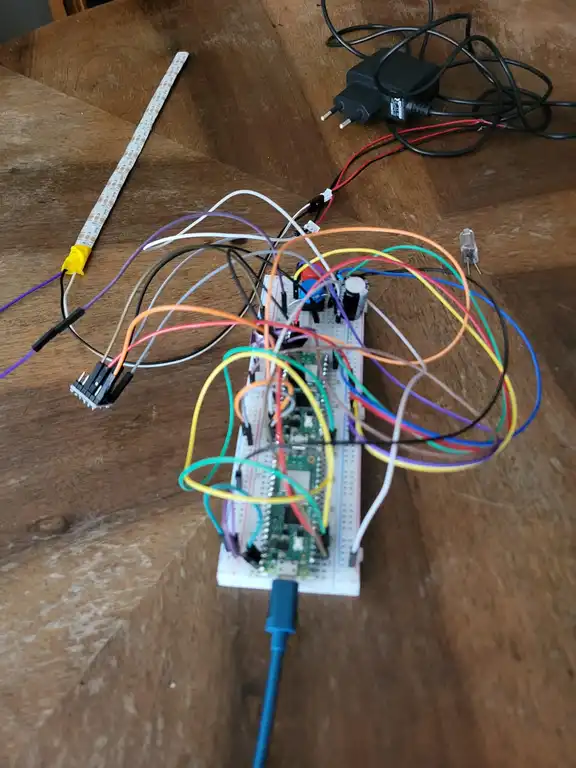Music Lights
A Raspberry Pi Pico system that synchronizes LED lighting with music
Author: Antonio-Christian Carazeanu
GitHub Project Link: link_to_github
Description
Music Lights is a project that uses a Raspberry Pi Pico to control an LED ring based on live music input. A microphone captures ambient audio, and a signal processing algorithm detects the beat and dominant frequencies. The LEDs react in real-time by changing color and brightness, creating an immersive audio-visual experience.
Motivation
The idea behind this project came from a desire to blend music with dynamic visual effects. I wanted to explore how embedded systems can process audio and produce synchronized lighting, making music more interactive and engaging.
Architecture
The project is composed of the following main components:
- Microcontroller: Raspberry Pi Pico running real-time firmware using Embassy.
- Audio Input: MAX4466 Microphone module connected to the Pico's ADC, capturing audio signals.
- Signal Processing: Algorithm performing FFT using the
microfftlibrary to analyze frequencies. - LED Control: LED ring controlled via the RP2040's PIO unit using
embassy-rpand a compatible WS2812 PIO program (likews2812-pioor similar). Requires a Logic Level Shifter (3.3V to 5V) for the data signal. - Output: WS2812 LED ring visualizing music dynamically.
Connections:
- Microphone Analog Out → Pico ADC GPIO (e.g., GPIO26)
- Pico GPIO (PIO Output) → Level Shifter (Low Voltage Input)
- Level Shifter (High Voltage Output) → LED Ring Data In (via ~330Ω resistor)
- Buttons → Pico GPIO Inputs (with 10kΩ pull-up/pull-down resistors)
- Pico USB → Power (for Pico) and programming
- Separate 5V Power Supply → LED Ring (+5V, GND)
- Separate 5V Power Supply → Level Shifter (HV Pin)
- Common Ground: Crucial connection between Pico GND, Level Shifter GND, and the Separate 5V Power Supply GND.
Log
- Week 5 - 11 May: Set up the Raspberry Pi Pico and assembled the main hardware components.
- Week 12 - 18 May: Completed the full hardware assembly and tested each component individually using example code. Encountered an issue with the LED strip: several LEDs were not functioning correctly, so I tried cutting off the faulty sections and re-soldering, but this did not fully resolve the problem. Ultimately, I replaced the LED strip with a WS2812 LED ring, which worked reliably in the final setup.
- Week 19 - 25 May: Finished the software code, adding more reactive modes for the LEDs.
The audio processing proved to be one of the most challenging aspects of the project, especially tuning the beat and frequency detection algorithms. It required significant trial and error to achieve reliable real-time responsiveness.
Hardware
- Raspberry Pi Pico W (x2 - one for development/debug)
- WS2812 LED Ring (24 LEDs)
- MAX4466 Microphone Module
- Logic Level Shifter Module
- Jumper wires (M-M, M-F) and Breadboard
- USB cables (for Pico power/programming)
Schematics
Project Photos





Bill of Materials
| Item | Quantity | Unit Price | Total Price |
|---|---|---|---|
| Jumper Wires for Breadboard | 1 | 7.99 RON | 7.99 RON |
| Raspberry Pi Pico W | 2 | 39.66 RON | 79.32 RON |
| Breadboard HQ (830 tie points) | 1 | 9.98 RON | 9.98 RON |
| White Pin Header 2.54 mm (40p) | 3 | 0.99 RON | 2.97 RON |
| Colored Jumper Wires Female-Male (40p, 15 cm) | 1 | 7.99 RON | 7.99 RON |
| Electrolytic Capacitor 1000 µF, 35 V | 1 | 2.99 RON | 2.99 RON |
| Electrolytic Capacitor 470 µF, 50 V | 1 | 0.79 RON | 0.79 RON |
| USB Cable | 1 | - | - |
| Addressable LED Ring WS2812, 24leds | 1 | 23,18 RON | 8.07 RON |
| Button 12x12x7.3 mm | 2 | 1.10 RON | 2.20 RON |
| Button Cap 12x12x7.3 mm, Blue | 1 | 0.34 RON | 0.34 RON |
| Button Cap 12x12x7.3 mm, Red | 1 | 0.34 RON | 0.34 RON |
| MAX4466 Microphone Module with Amplifier | 1 | 7.18 RON | 7.18 RON |
| 4-Channel Logic Level Converter Module | 1 | 4.00 RON | 4.00 RON |
| 330 Ω Resistor | 2 | 0.12 RON | 0.24 RON |
| 10k Ω Resistor | 1 | 0.13 RON | 0.13 RON |
| Sursă alimentare 5V | 1 | 23.38 RON | 23.38 RON |
| Conector DC mamă | 1 | 2.07 RON | 2.07 RON |
| Conector JST PH2.0 2P | 2 | 2.00 RON | 4.00 RON |
| Jumper Wires Male-Male (40p, 30 cm) | 1 | 8.00 RON | 8.00 RON |
| Conector pentru LED | 1 | 2.99 RON | 2.99 RON |
Estimated Total: ~ 188.38 RON (excluding USB cable)
Software
This list details the recommended Rust crates for the "Music Lights" project using the Embassy async runtime on the Raspberry Pi Pico, based on the provided code.
| Library | Description | Usage |
|---|---|---|
embassy-executor | Core asynchronous task executor. | Runs all concurrent operations. (Ex: Spawner) |
embassy-time | Async time primitives (Delay, Timer, Instant). | Essential for timing and scheduling. (Ex: Duration, Ticker, Instant) |
embassy-sync | Async synchronization tools (Mutex, Channel, Signal). | Enables safe data sharing between async tasks. (Implicitly needed for Atomic... in concurrent contexts) |
embassy-rp | HAL for RP2040 peripherals (ADC, GPIO, PIO, etc.). | Async access to hardware on the RP2040, including WS2812 control via PIO. (Ex: Pio, Adc, Input, PioWs2812) |
smart-leds | Utilities and types (RGB8, effects, gamma, brightness). | Defines LED colors and can be used for visual effects. (Ex: RGB8) |
libm | Pure Rust implementations of C math functions (sqrt, powf, etc.). | May be required for math operations in signal processing or effects. |
panic-probe | Panic handler for embedded targets. | Works well with defmt for debugging. |
defmt | Efficient logging for embedded (RTT). | Enables lightweight debugging output. |
defmt-rtt | RTT backend for defmt. | Enables real-time logging via debug probe. |
core::sync::atomic | Atomic types from the core standard library. | For thread-safe atomic operations between tasks. (Ex: AtomicBool, AtomicU8) |
Detailed Design
The "Music Lights" firmware, written in Rust for Raspberry Pi Pico, uses the Embassy asynchronous runtime. All core logic resides in main.rs.
1. Core Control Flow (Main Loop @ ~67 FPS):
A Ticker drives the main loop. Each iteration involves:
- Button Input: Debounced reads from two buttons (
PIN_14,PIN_15) modify global state:- Button 1: Toggles
MIC_MODE(music/solid) and cyclesCOLOR_INDEXif switching to solid. - Button 2: Cycles
VISUALIZATION_MODE(if music) orCOLOR_INDEX(if solid).
- Button 1: Toggles
- Audio Processing: An ADC sample (
PIN_26) is processed byFastAudioProcessorto yield anAudioAnalysisstruct (amplitude, energy, beat). - Visualization:
- If
MIC_MODEis true, avisualize_...function (selected byVISUALIZATION_MODE) usesAudioAnalysisand astepcounter to generate LED patterns. - If
MIC_MODEis false,solid_color()(based onCOLOR_INDEX) determines the LED color.
- If
- LED Output: The
RGB8array is sent to the WS2812 ring via PIO/DMA (PioWs2812). - A
stepcounter for animations is incremented.
2. State Management:
Global state is managed via core::sync::atomic variables, updated by button logic:
MIC_MODE: AtomicBool: Music reactive vs. solid color.COLOR_INDEX: AtomicU8: Current solid color.VISUALIZATION_MODE: AtomicU8: Current music visualization.
3. Audio Processing (FastAudioProcessor):
This module performs lightweight, real-time audio analysis without a full FFT:
process_sample(sample: i16):- Calculates instantaneous amplitude, RMS energy (from a small sample buffer), and peak amplitude (with decay).
- Detects beats by comparing current RMS energy to a historical average, considering an energy threshold and a debounce timer.
- Output (
AudioAnalysisstruct): Provides normalized amplitude, peak, energy, and a beat flag.
4. Visualization Functions:
A suite of visualize_... functions translate AudioAnalysis into LED effects (e.g., visualize_rainbow_wave, visualize_vu_meter, visualize_beat_pulse). Utility functions like wheel() and solid_color() assist in color generation. BeatVisualizerState manages state for the beat pulse effect.
5. Hardware Abstraction (Embassy-RP): Embassy HAL crates provide asynchronous, non-blocking access to RP2040 peripherals:
- PIO & DMA (
PioWs2812) for WS2812 LED control. - ADC (
Adc,Channel) for microphone input. - GPIO (
Input) for buttons. - Interrupts (
bind_interrupts!) for PIO and ADC. - Timing (
Ticker,Instant,Duration).
6. Asynchronous Execution (Embassy-Executor):
The #[embassy_executor::main] task orchestrates all operations. The use of async/await and the Ticker ensures a responsive system with a consistent update rate for animations.


